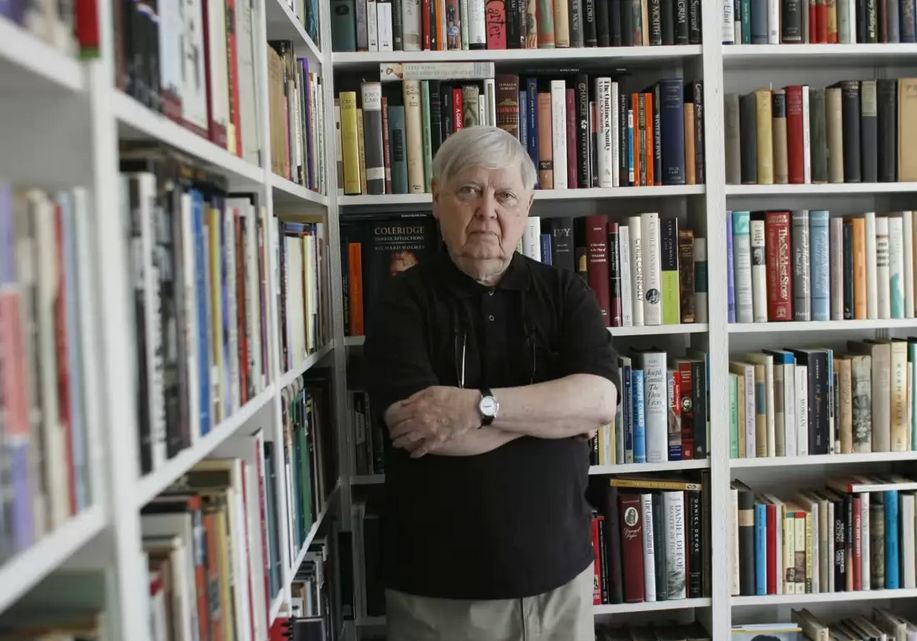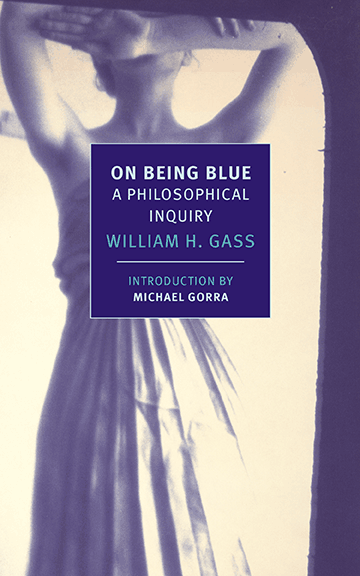The first blue words of this book seem to form “a soft quality in the air, a color, a flutter: permanent in their passage.” Like starling murmurations on cold winter mornings, for Gass, blue is a thought without a centre; meaning softly gathers around the word the way lint collects and, at the turn of a forgotten page, takes flight. In this sense of the word, Gass writes in blue with the language of birds… —Sebastian Ennis
In spite of its philosophical dressing, On Being Blue is really a long essay on language written with elegant exaggeration and a self-mocking pretentiousness. First published in 1976, it reads like a flight of fancy. Gass is noticeably freer with his prose here than in his earlier fiction and he uses that freedom to explore language in its broadest sense as a way of forming meaning in the world (a recurring theme in his later literary essays). Michael Gorra, in his introduction to its republication this month, places On Being Blue within the linguistic turn of that period’s academic criticism, at a time when written English had grown ever closer to the spoken tongue. Now we’re used to taking liberties with the written word to make it sound more like speech. So I suspect few people will sympathize with Gass’s highbrow defense of the art of language, what is best described as his French aestheticism, which he masks with American grit. That being said, I’m one of those people. I believe language is more than its uses, more than the way we commonly speak. It’s figurative, too. So take a word like blue—it’s straightforward, you can point to its correlative in physical experience, it’s there. When we say it we think we know exactly what we mean. But then follow Gass from cover to cover and you may begin to see and say things differently.
First, ignore the philosophy that says there’s any strict or arbitrary relationship between words and things. Gass was a philosophy professor at Washington University, but he avoids theory here and so should we. Let’s just talk blue: “Blue pencils, blue noses, blue movies, laws, blue legs and stockings, the language of birds, bees, and flowers as sung by longshoremen, that lead-like look the skin has when affected by cold, contusion, sickness, fear.” Gass begins with this list, which he returns to over and over again.
Read it out-loud for all to hear! (No, really…give it a try.) The first blue words of this book seem to form “a soft quality in the air, a color, a flutter: permanent in their passage.” Like starling murmurations on cold winter mornings, for Gass, blue is a thought without a centre; meaning softly gathers around the word the way lint collects and, at the turn of a forgotten page, takes flight. In this sense of the word, Gass writes in blue with the language of birds—but I’ll return to this.
Now listen. Blue. Sound it out slowly. I hear a stone dropped in water as someone blows dust off a book jacket; it’s a wet syllable caught in flight between the lips that the stumbling tongue elbows. When we speak we seem to spit blue. While ink fills blank spaces with form and meaning between nouns and verbs, the physicality of the word, Gass reminds us, with tumbling breath over pursed lips, comes from the heart of language and is released into the world.
Yet of all the colours worth the ink and all the words of breath’s embrace, why choose blue? Let’s not mix words here . . . or let’s, Gass certainly does: “Whether slick light sharp high bright thin quick sour new and cool or low deep sweet thick dark soft smooth heavy old and warm: blue moves easily among them all, and all profoundly qualify our states of feeling.” The country of blue that Gass takes us to is an inner world, unfolding in language: flung past milky tooth and watered sanguine gum, dragged behind dripping nib, and tossed by battered key.
If Gass offers us a lesson here it’s that feelings, like colours, do exist; and not entirely without words, which flock and swarm and come to rest upon the world. Blue is spoken seen felt read and thought, in the world and the heart and the mind, and in all the places in-between where words collect.
Gass, a writer’s writer, chronicles this pursuit of language, which seems to dwell everywhere and nowhere and in-between the two in that place he calls blue. It’s the in-between he’s after. Just as the sky touches the ground, but only in the distance and only on clear days: it’s a shade of blue he can’t quite put his finger on. Thankfully, many writers, artists, scientists, and philosophers seem to have journeyed there or thereabouts, and some appear in Gass’s thick, dark prose.
Yet it’s the blue-hue of his own writing that caught my eye. He writes blue lists that transcend nowhere: “blue bloods, balls, and bonnets, beards, coats, collars, chips, and cheese.” Tongue-in-cheek, his rambling voice follows the booming, brazen blue smear his hand drags across the page, painting a vivid picture of all the blues that fill the world. Other times, he wrestles with language for sheer sport, producing a fearless literary slapstick between the covers. And as for the blue we find there, well . . . it’s “appropriate that blow and blue should be—at our earliest convenience—utterly confused.” It takes an author like Gass to tackle words with such rough wit and yet embrace the very sound of writing as if it were a lover’s howl.
It’s the literary equivalent of a wink and a nod, but he makes his point. Reading Gass, words get mixed up with each other and with the things they describe. But Gass is unapologetic. On Being Blue is no guide for the perplexed. Language is not so cut and dried; it’s wet and torn, coffee-stained, beaten, broken, and scorned, twisted and crumpled, contorted, thrown away, and then forgotten, lost near the tip of tongue, found by index finger and thumb, and set flying with a flick of the wrist. That is, for Gass, it takes a great deal of confusion to say or write anything that truly means something. And that’s not a criticism. Nor does it imply that great writing must be complex. It celebrates the way language sets things in relation to one another and utterly confuses words, feelings, thoughts, colours, and things.
So Gass doesn’t hold too tightly to words, but lets them fly: “blue pencils, blue noses, blue movies . . . dumps, mopes, Mondays . . . watered twilight, sour sea.” They’re all blue when spoken in the language of birds. On Being Blue will have you coughing up feathers, picking words from your teeth that don’t stick to your tongue, and, by the end, chirping like a madman until you’re blue in the face.
—Sebastian Ennis



Great review. Wonderful turns of phrase. And, of course, it makes me want to read the book.
No beginners luck here; just straight technikos!